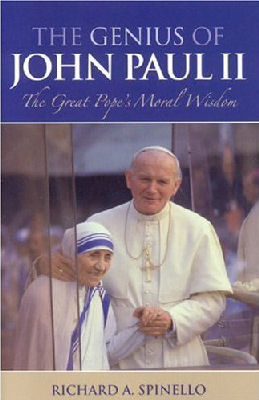
|
Posted February 6, 2007
Book: The Genius of John Paul II: The Great Pope’s Moral Wisdom Author: Richard A. Spinello Sheed and Ward, Chicago. 2006. Pp. 237 An Excerpt from the Jacket:
The purpose of this book is twofold: it not only persuasively presents the late pope’s vital teachings, but also defends them against his critics. This important new work preserves and promotes the extraordinary legacy of John Paul II by focusing on his championing of universal human dignity and objective moral truths. An Excerpt from the Book: Conscience Given the lasting significance of our choices, we need to choose prudently. But how do we know how to make the right choice? Moral quandaries abound in one’s personal and professional life. Fortunately, each human being has a moral conscience, a “secret sanctuary,” where he or she can find refuge and where “God’s voice echoes.” This voice of conscience comes in stillness and silence, in the depth of our souls. Conscience enables us to resolve moral dilemmas and to formulate a moral judgment from among the alternative choices (or “proposals”) we are considering. In Veritas Splendor and in Dominum et Vivificantem John Paul II devotes considerable attention to this topic. This attention seems needed, given the tendency in today’s culture to equate “following one’s conscience” with subjectivism or to confuse conscience with a superego like awareness of conventional norms. John Paul II is quite clear that conscience “is not an independent and exclusive capacity to decide what is good and what is evil.” Rather, conscience is awareness of moral truth, of what is the right thing to do. John Paul II’s conception is squarely in line with the Thomistic tradition. Aquinas regarded conscience as an intellectual act of judgment. For Aquinas and for John Paul II, the work of conscience begins with awareness of the guiding principles of morality. These principles include Christian moral norms, such as the norms of the Decalogue, which are derived from the natural law and through divine revelation. Conscience is a “witness for man: a witness of his own faithfulness or unfaithfulness with regard to the law.” What follows is the application of these moral norms to a particular, concrete situation. One reasons from principles to a practical conclusion, which is expressed as a command of our conscience or practical reason: “This action is morally right and should be carried out,: or “This action is wrong and it should be avoided.” We can choose either to agree or to disagree with this practical judgment of conscience. As Germain Grisez put it, “Conscience is one’s last and best judgment concerning what one should choose.” Finally, conscience continues its work by inducing us to compare the actual choice with one’s judgment regarding the choice one should have made. Catholics believe that the Church, through the Magisterium, offers moral guidance that must form their consciences. No one who professes to be a faithful Catholic should ignore that guidance. Moreover, given the unerring charism of the Church in matters of faith and morals, that guidance is equivalent to the moral truth. Thus, a judgment of a well-formed conscience cannot conflict with the Church’s teaching since that teaching embodies the moral truth. According to John Henry Cardinal Newman, before revelation, conscience operated on the natural level as an “inward guide.” But in the aftermath of revelation, conscience becomes “the voice of Scripture, or of the Church, or of the Holy See.” Thus, “Christians have a great help for the formation of conscience in the Church and her Magisterium.” Table of Contents: 1. Faith, reason, and morals 2. Competing moral visions 3. The nature of the human person 4. Freedom, the good, and the moral law 5. The moral person 6. Ethics for modern life 7. Conclusions Appendix: The life and writings of Pope John Paul II |
|
